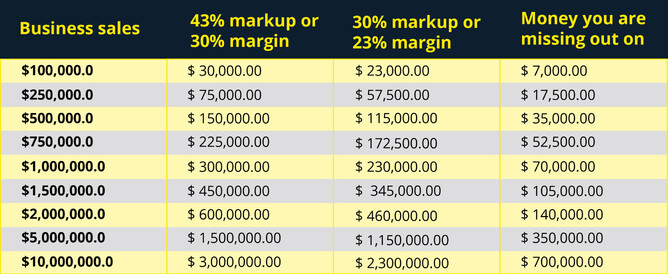To accurately track profit and loss on your plumbing jobs, producing accurate plumbing estimates is key. Pricing a plumbing job is the process of estimating the materials, labour, subcontractors, equipment, and overhead costs involved in completing a job. In this article we are going to show you the things you need to consider when pulling together your plumbing estimate.
Why are plumbing estimates so important?
Every plumbing company knows that estimating plumbing jobs is a critical part of running their business. A robust quote is crucial to gaining customer trust, winning the work, avoiding disputes, and last but certainly not least - making money.
With tightening lending restrictions and construction costs skyrocketing, borrowing money from the bank is becoming harder for homeowners and banks are starting to require fixed price quotes from plumbers to secure funding.
Figuring out how to price plumbing jobs can be difficult, and many experienced plumbers still make mistakes. Part of this is because each company’s estimating process is their ‘special sauce’ and they don’t want to give it away to their competitors.
Luckily for you, in this article we’re going to lift the lid on everything you need to know on how to estimate plumbing jobs. Keep reading for information on:
What to include in your plumbing estimate
One way to leave a good first impression with a customer is to be able to provide them with an estimate of the cost to do the work. Every customer wants to understand cost when they hire a plumber to make sure its within their budget. Being able to provide an estimate gives the customer confidence in you and your business. Giving a verbal estimate is a good starting point but following up with a written estimate gives them much more confidence in you.
A good estimate should include:
- Your contact information
- Summary of the project
- Scope of work
- Highlight any risks you see (what cause end up costing the customer more)
- List of materials
- Estimated cost to complete the work
- Any permits required
- Your insurance cover
- You PGDB license details
- Work guarantee
- Any photos of the job
If there are other things you would like to include, go for it. The estimate you provide is one of the first touch points a potential customer has with you, you want it to communicate that you are a professional and the best choice for the job.
Setting your plumbing charge out rate
Unfortunately, too many plumbers look at what their competitors charge out rates are and assume that they can use the same rate. While this may work out for you in some cases, assuming you’re competitors have not made any mistakes, its critical that you build up your own hourly rates to make sure you are factoring in the employment costs, the margin you need to run your business, as well as making the money you want to be making.
There are a few different ways to figure out if you’re charging enough, which you can check our article out here on this. But as you build this rate up you need to consider the following:
- Employee wage
- ACC
- Holiday, Sick and Statutory Pay
- Kiwisaver
- Training time
- Business development time
- Margin
Once you have built your rate up and know you are covering your costs and making the money you need to be on top of that, you can compare it to your competitors and adjust accordingly.
Check out our free charge out rate calculator below and use it to make sure you are charging enough!
Plumbing materials, supplies and specialist equipment required
Materials and supplies
Generally speaking, establish the materials and supplies required for a project is the easy part. If you are replacing a hot water cylinder as an example, you will need things such as:
- A hot water cylinder
- Seismic restraints
- Valve pack
- A few metres of pipework
- A cylinder tray
Where estimating materials can get a bit trickier is with plumbing fixtures and tapware. Fixtures and tapware can vary is cost dramatically a close coupled WC can range from $100 through to over $1,200 depending on a customers preference. Understanding their expectations on quality is critical to helping them understand the estimated costs to do the work.
Something that most plumbers forget to factor in, or consider the costs of these items to be negligible when estimating is consumables. Things like uPVC primer and glue, silicone, hemp or PTFE tape. These ‘negligible’ costs can add up over a year and have been known to shock some business owners when they find out how much money they are losing by not considering them in their estimates.
Specialist equipment needed to complete a job
Factoring in specialist equipment required to complete a job is important to make money. Put simply, specialist equipment is any equipment not in your toolbox.
Say, for example, you don’t own a hydro-jet and drainage CCTV rig. You are called out to a blocked drain and think its best to use these pieces of equipment to complete the job. You can easily rent one but the cost would have to be included in your plumbing estimate.
This means understanding the different tasks required to complete a job before you estimate is important to accurately assessing all costs that could occur on a job.
Calculate the time to do the job
The time required to complete a job is far harder to predict. Often there are external events that affect how long a job takes, things like:
- Missing materials resulting in an extra trip to the merchants
- Being held up on site because another trade is behind
- Connecting to an existing system only to find there is an issue with it
- Call backs if there is defective work
- Bad traffic resulting in longer travel times
Often plumbing businesses estimate time based on the ideal scenario resulting in the fastest time to complete the work, and forget to consider the variables that will impact it.
This is often the part of a business that can need the most refining over time to maximise efficiency and will vary the most from business to business, and location to location.
Additional labour costs
Some plumbing jobs may require you to subcontract work to be done by other trades such as an electrician needing to wire a hot water cylinder or a drainlayer needing to do the drainage work.
If they are working as a subcontractor to you, its critical you get their costs to include in your estimate to your client. Providing an estimate without consulting your subcontractors could result in you losing margin – after all, no one likes someone setting their price for them!
As a plumber, it’s vital to have a reliable network of tradespeople you can call upon, and know their rates.
Overheads
Overheads can be split into two categories:
- Business overheads
- Project overheads
Plumbing Business Overheads
Business overheads are costs that are essential to running a business, but cannot be directly attributed to a revenue source. Some examples of business overheads are:
- Administration staff
- Software subscriptions
- Water and electricity
- Office rent
Making sure these costs are recovered over the year is vital to staying in business.
Plumbing Project Overheads
Project overheads are costs that are essential to running a project, but cannot be directly attributed to a revenue source. Some examples of business overheads are:
- Scaffolding
- Building permits
- Compliance certificates
- Site meetings
Making sure these costs are recovered on the project specifically is vital to maintaining project margin, and making a profit.
Markup vs margin
A lot of plumbers go into business with the best intentions but misunderstand the difference between markup and margin. Most plumbing businesses aim for a 30% margin, and if you think that taking your costs and adding 30% will do the trick, you will be chasing your tail making little to no money on jobs. While we have an in-depth article explaining markup and margin, let us explain it briefly here.
Put simply, the dollar value of markup and margin is the same. However, the point of reference it is measured from changes, and therefore the percentage of the value changes as well.
If you bought something for $100, and added a 50% markup to it, you would charge that to you customer for $150 (100 x 50% = 50; 100 + 50 = 150). The margin in this example is also $50. However, because margin is measured from your sales price and not your purchase price, the margin on this is only 33% (50 / 150 = 33%).
Using the same example, assuming you used a 33% markup (100 x 33% = 33; 100 + 33 = 133), your margin would only be 25% (33 / 133 = 25%).
By misunderstanding these two numbers and misapplying them, you will lose $17 for every $100 of cost to your business. When you look at this at a $100 cost to your business, this might not seem like much, but let's look at the impact over larger sums:
As you can see from this table, you could be missing out on a lot of money when you incorrectly apply these two metrics.
Contingency
Depending on how comfortable you are with the estimate you are producing, you may want to add contingency onto it for any unknowns. The more accurate the information you have, the less the contingency should be, the less accurate the information you have, the larger the contingency allowance should be.
For example, you need to repair a drain running under the property, but you don’t know exactly where the drain is or how deep it is. If the depth of the excavation needs to be great than 1.5m, you will need to install shoring to meet health and safety obligations. The risk of not knowing the depth of the drain or its exact location is high, so you want to communicate that to your customer, as well as add contingency to reduce the chances you need to ask the customer for more money later.
Add it all up
Once you have calculated your:
- Materials, supplies, and equipment costs
- Time to do the work and charge out rate
- Project overheads
- Margin
You just need to tally this up which will give you a bottom line number that can be presented to the client. How much visibility you choose to show the client comes down to you, but generally they will want some level of visibility as to the different costs they are incurring.
The bottom line on pricing a plumbing job
Providing a good, robust, clean estimate can help a customer make a good decision, present your business as a professional company that knows what they are doing, and lead to you winning the job.
As strange as it sounds, you don’t necessarily want to be the lowest price compared to your competition. People may wonder why your prices are so cheap and question your professionalism.





